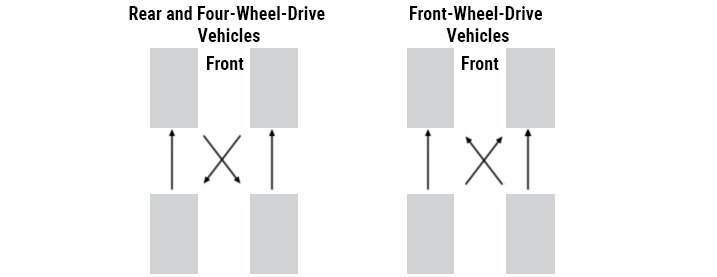We started this article with a desire to answer the question: "how often should my vehicle's tires be rotated?" It's a valid question. But the more research we did to answer it, the more we came up with additional, and equally important, questions which also deserved answers.
So our article is now entitled "9 FAQs About Tire Rotation". We of course are providing the answers to these questions:
- 1. What are the advantages to rotating my tires?
- 2. What mileage interval should I use?
- 3. Does my tire warranty influence my rotation schedule?
- 4. How does snow tire usage influence rotation decisions?
- 5. Can I do it myself or should I take it to a shop?
- 6. Should I include the spare in the rotation?
- 7. Does rotation require me to check the tire pressure?
- 8. What rotation pattern should I follow?
- 9. Are there tires which should NOT be rotated, such as staggered, asymmetric, or unidirectional?
What are the advantages to rotating my tires?
Front and rear tires perform different functions on a vehicle: the fronts steer, and take higher loads than the rear when turning; front tires put the engine power down on front-wheel-drive cars, while rears do it of course on rear-wheel-drive cars. Because of these and other factors, front and rear tires wear at different rates. For longest tire life, it is a best practice to rotate tires front-to-rear, which evens out the wear and assures the longest possible use out of a set of tires. It's also one of the easiest and cost-effective maintenance tasks you can do.
What mileage interval should I use?
As a general rule, we recommend rotating tires every 7,500 to 10,000 miles. This will vary based on your driving style and mileage. Aggressive driving, performance tires, or above-average mileage will require more frequent rotations. Another suggestion is to rotate your tires at every oil change. Most modern vehicles have oil change intervals at around 10,000 miles. This makes it easy to remember, and allows you to schedule two service jobs at the same time. If you're asking this question for a set of tires you've just bought and installed, be sure to read the answer to Question 3.
Does my tire warranty influence my rotation schedule?
An exception to the general mileage suggestions offered above would be in cases where a new set of 4 tires has been installed. We strongly suggest paying careful attention to the warranty information provided by the tire manufacturer.
In many cases, the treadwear portion of the warranty is conditional on documented tire rotations, performed at intervals prescribed by the tire maker. In checking several specific manufacturers, we see rotation intervals at 8,000, 6,000, and as low as 4,000 miles. Documentation is required! One tire manufacturer provides a form to be completed that looks like this:

How does snow tire usage influence rotation decisions?
If you live in northern climes where snow tire usage is common, you're used to the semi-annual ritual of swapping the snow tires onto the car in late autumn, and removing them again as soon as spring breaks through. Whether your tires are mounted on wheels or not, here's what's important: mark each tire as it's removed with its location (LF, RF, LR, and RR). Use a tire crayon, carboard label, whatever works for you. When it's time to remount your regular tires, rotate them, and save yourself the effort of taking all the tires off a second time.
Do the same for your snow tires: mark their locations, then rotate them each season. What is often forgotten about the 'extra' expense of a 2nd set of tires is that each set should have double the life expectancy (based on age, not mileage), as you are using each set for only about 6 months of the year. Rotating them will maximize that life expectancy.
Can I do it myself or should I take it to a shop?
Rotating tires is, at least theoretically, an easy DIY job. However, you will need some special tools, including at least two and in some cases four jack stands, and a floor jack. It's also a best practice to have a torque wrench in order to retighten the lug nuts or bolts to the correct tightness.
If you use an authorized dealership or independent repair shop for regular maintenance, it may be easier to ask them to rotate your tires. Some will do this task as a regular part of their service; others will charge little or no extra money to do this, as this also gives them the chance to check your brakes and suspension. If you don't own the necessary equipment, using a shop for the rotation may be your best bet.
Should I include the spare in the rotation?
In the good old days, when cars had full-size spare tires which exactly matched the road tires, it made sense to include the spare tire in the rotation. After all, this would be like driving on 5 tires, with only 4 of them on the ground at any one time, and would conceivably result in about 20% longer tire life.
But starting in the late '60s with 'space saver spares', and then a bit later with 'temporary spares', it became impossible to include the spare in the rotation. Temp spares are lighter and smaller than regular tires by design; they are intended to be 'in use' for limited mileage. Unless you know for a fact that your vehicle (typically a truck) has a full-size spare, the spare is not included in the rotation schedule.
Does rotation require me to check the tire pressure?
It's a best practice to check tire pressures about once a month, more frequently if you drive more than the national average of 15,000 miles a year. If you're rotating tires once or twice a year, this becomes a convenient time to also check pressures.
However, there is a more important reason to check pressures when rotating. Many of today's cars call for different pressures front and rear. If, for example, your vehicle's tire pressure label states "30 PSI front" and "34 PSI rear", and the pressures are not reset, then all 4 tires will have incorrect pressures after the rotation! So make it a point to check and adjust the pressures every time you rotate.
What rotation pattern should I follow?
Most tire companies recommend a rotation pattern that moves tires from front to rear and rear to front, with ONE set of tires also crossing over from left to right and right to left.
The recommended pattern differs a bit whether the vehicle is FWD/RWD/AWD. In our research, we found these two patterns to be most common:

Alternatively, simply rotating the tires front-to-rear, with no cross-rotation, is better than not rotating them at all. What is important is to check the tread for any signs of abnormal wear, which could influence your pick of a rotation pattern.
Are there tires which should NOT be rotated, such as staggered, asymmetric, or unidirectional?
Taking staggered tires first, which are defined as different sized tires front to rear (larger on the rear), these cannot be rotated front-to-rear. Vehicle behavior would be adversely affected if the larger tires were on the front, and vice versa. In some cases they simply will not fit. Although not a typical rotation pattern, staggered tires could be rotated left-to-right, with the fronts staying on the front and the rears staying on the rear.
Asymmetric tires are defined as tires whose tread pattern differs from left to right. Correctly mounting an asymmetric tire on a wheel is critical; the OUTSIDE of the tire tread must be on the outside of the wheel. However, once such a tire is mounted, it can be used on either the left or right side of the vehicle. So asymmetric tires can be rotated using any of the common rotation patterns we presented earlier.
Unidirectional tires are designed to revolve only in the direction indicated by the arrow on the sidewall. When buying a set of unidirectional tires, two will indicate clockwise direction, and two will indicate counter-clockwise. Once they are mounted on wheels, they must always remain on the same side of the vehicle. This means that unidirectional tires cannot be cross-rotated. It is appropriate, though, to rotate them front-to-rear as shown in this diagram:


